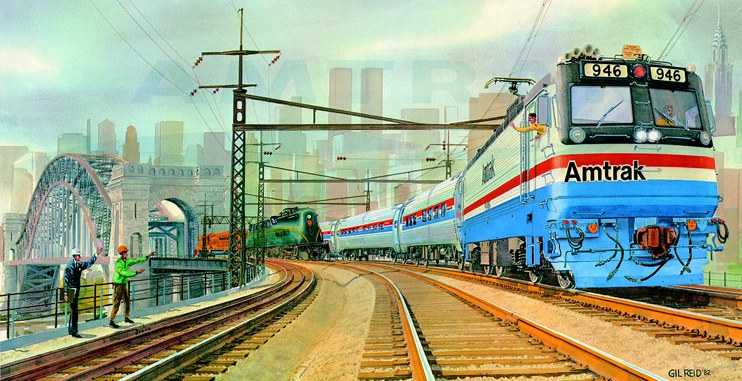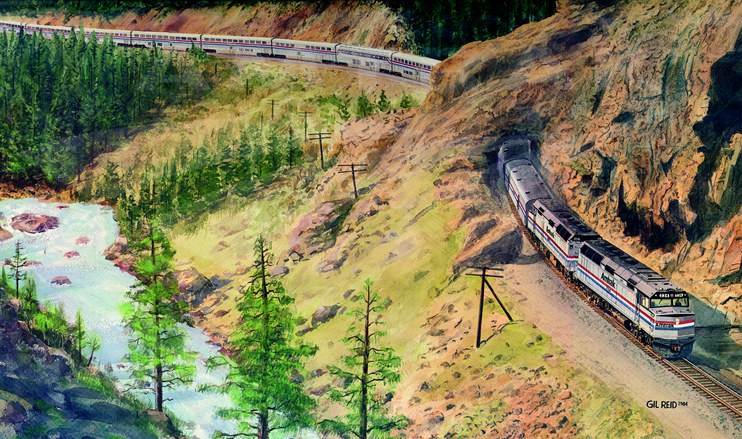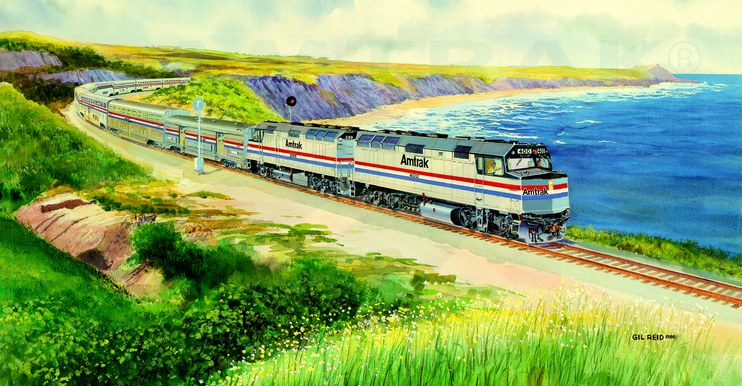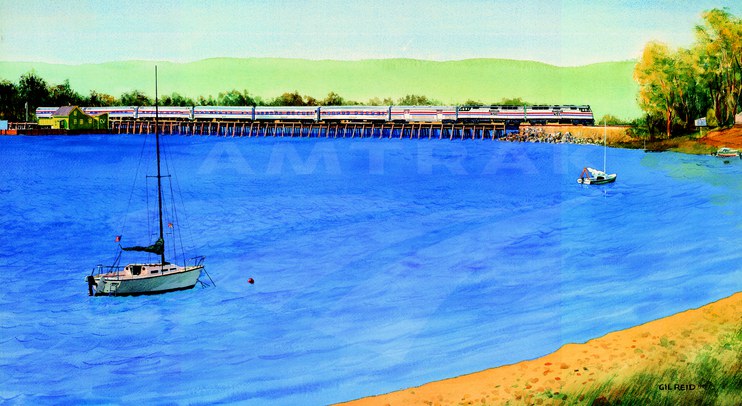Gil Reid and the Art of the Amtrak Calendar
CommentsJanuary 27, 2014
Since their origins in the early 19th century, American railroads have been savvy in the use of imagery to advertise their services and attract riders. While passengers choose the train to fulfill the basic need to get from one place to another, part of the allure of a rail journey has also been the show right outside the window. As the train passes through the changing landscape and makes its scheduled stops, we’re allowed brief glimpses into the lives of others.
The upper third of the Amtrak wall calendar always
includes artwork.
Late 19th century railroads understood this natural human curiosity about one’s surroundings, and thus employed art depicting far-off places to entice travelers to buy tickets and explore the country. Brochures, buttons, posters and other items featured paintings, illustrations and photographs that provided national exposure to young and established artists alike. Advancements in printing technology during the Industrial Revolution meant that the railroads could produce high-quality, full color items at relatively low cost.
One of the most beloved items, eagerly awaited by rail aficionados, was the railroad calendar. It usually featured a copy of an oil painting that highlighted aspects of the rail system, whether a flagship train, new equipment or a soaring piece of infrastructure.
According to railroad historian Dan Cupper, the origins of the first railroad calendar are unclear, but the Boston & Maine Railroad is known to have issued a small calendar in the 1880s. By the early 20th century, major systems such as the Pennsylvania (PRR), New York Central and the Atchison, Topeka and Santa Fe (Santa Fe) railroads were producing large format calendars embellished with specially commissioned art.1
Most calendars were given to freight customers as signs of appreciation for their business, while others were distributed to stations and depots to decorate waiting rooms. In union stations shared by two or more railroads, calendars staked out rival territory. The beauty of the original artwork attracted the public too, and railroads generally sent calendars free of charge to persons who requested one. By the 1950s, the PRR produced more than 300,000 calendars, while the Chesapeake and Ohio had a run that reached 450,000 copies.2

Artist Gil Reid sketches the Susquehanna River Bridge
for the 1980 calendar.
Once the New Year had passed and the excitement of the calendar had faded, the original artwork—usually large oil paintings—went on display in corporate offices or important stations. For companies like the Santa Fe and PRR, oil-on-canvas works remained the standard. Lacking the crispness of a photograph, they allowed the viewer to fill in the details with his or her own imagination, and therefore engage with the image on a deeper level.
In attempts at cost savings, most major railroads had discontinued their calendar programs by the time Amtrak began operations in 1971. Amtrak would revive the tradition in 1974 in partnership with the Auto-Liner Corporation of Omaha, Neb., which assisted Amtrak with route and equipment planning and later inspected and refurbished many of the cars that made up the early Amtrak fleet.3
Creating a calendar was not first and foremost on the minds of early Amtrak leaders, whom had an immense task before them, including the need to create an organizational framework; hire and train employees; upgrade and standardize rolling stock and station facilities; institute a comprehensive national reservations system; and craft an advertising campaign to inform the public about its services.

The 1981 calendar celebrated Los Angeles' 200th anniversary.
William Kratville, head of the Auto-Liner Corporation, decided to publish the first Auto-Liner/Amtrak calendar in 1971—before the new National Railroad Passenger Corporation had begun operations or gained its present name. Since the final makeup of the rolling stock and locomotive fleet was undetermined, it showed a historical view of the 20th Century Limited by artist Gil Reid. Kratville would go on to create calendars in the succeeding two years. Amtrak first contributed funds towards the 1974 calendar, which featured a Reid watercolor of the Amtrak Super Chief racing across the desert.
By 1976, Amtrak had taken complete control of the calendar program, producing wall versions that measured approximately 23.5” x 33.5”. Since then, the calendar has featured the work of noted railroad artists Gil Reid, Ted Rose, J. Craig Thorpe and others, in mediums including watercolor, oil-on-canvas and photography. An article in the January 15, 1977, issue of Amtrak NEWS noted that once the year was over, “the painting can be cut off and framed.” That year, the calendar cost $3.50.

The New England Metroliner and GG-1 No. 4935 meet on the Hell Gate Bridge.
Of all the artists whose work has graced the official Amtrak calendar, Gil Reid holds the record for most pieces featured. His 18 works showcase trains such as the Empire Builder, National Limited, Broadway Limited, Auto Train and Crescent; E-60, AEM-7, F40PH and P30CH locomotives; and significant infrastructure including the Horseshoe Curve, Susquehanna River Bridge and Los Angeles Union Station.
Reid was already well-regarded for his accurate depictions of train equipment and railroading scenes when he began the Amtrak commissions in 1974. Though born in St. Louis in 1918, Reid spent most of his childhood in Richmond, Ind., along the tracks of the Pennsylvania Railroad. Like many young boys of the time, he traced his lifelong love of the railroad and its people to Lionel and American Flyer toy trains.4 He headed to the Windy City as a young man, pursuing coursework at the Chicago Academy of Fine Arts and doing advertising artwork for retailer Montgomery Ward. During World War II, Reid served in the Army in Europe and received a Purple Heart.5

The California Zephyr traverses the Rocky Mountains west of Denver.
Returning to the United States, Reid entered a career in commercial art, eventually working full time for Kalmbach Publishing—the company behind Trains and other railroad magazines—as an assistant artist and then assistant art director.6 There, he executed pieces in acrylic, watercolor and pen and ink that graced the pages of Kalmbach publications. By 1978, he left the world of publishing to devote himself full time to painting, settling in a studio in Elm Grove, Wis., that overlooked Soo Line tracks. Throughout his career, Reid would be honored with numerous awards, including one for “Senior Achievement” from the Railway and Locomotive Historical Society.7
Sara Kaploe, Gil Reid’s daughter, recalls that during her childhood, while her father was with Kalmbach, he worked in his basement studio most nights. Although versatile in many mediums, watercolor was his favorite. He also had a large model railroad for which “he painted all the background scenes and the small details,” says Kaploe. On weekends, Reid traveled to art shows, selling watercolors and paintings, while also establishing friendships with fellow rail enthusiasts and collectors. His daughter adds, “He loved what he did and sharing his passion.”8

Between the stations at Ventura and Lompoc, the Coast Starlight hugs the stunning California coast.
“Dad was a real people person who could talk to anyone…I think he was surprised and happy that people responded so positively to his work,” says Kaploe. After moving to Olathe, Kan., many years ago, she stopped at a local McDonald’s, where she found the walls lined with her father’s work. The owner, a rail enthusiast, had decorated the restaurant with Reid’s prints. “When I took him there later, Dad was just awe struck, but so pleased,” Kaploe recalls.
For most of Reid’s association with the Amtrak calendar, he worked with Director of Special Projects Bruce Heard, who would consult with the President and CEO on a theme for the year. With the subject chosen, Heard and Reid discussed the overall design to include the location and equipment to be featured.9 Commenting on the relationship between Amtrak and its calendar artists, Heard once noted, “I rely heavily on the artist; I want the artist to tell me if I’m wrong [from an artistic standpoint].”10 While it was important to convey Amtrak in the best light, the artist was allowed freedom in his methods. Back in his studio, Reid worked from memory as well as sketches and photographs made during the location scouting trip.

The Montrealer glides across Lake Champlain south of the
Canadian border.
Gil Reid’s work for Amtrak, primarily done in watercolor, displays his technical precision and signature attention to detail. The bright but soft colors of the landscapes—greens, pinks and browns—evoke a happy, positive response from the viewer, while the trains’ bold red, white and blue paint schemes draw one’s eye to the equipment. In many cases, Reid effectively used subtle color variations and light pencil lines to create additional texture. Through thoughtful perspectives, trains often stretch into the distance, allowing the viewer a closer look at the various locomotives and cars. Although beautiful landscapes, including snow-capped mountains, bayous and stark deserts, are found in the paintings, the trains always take center stage.
The image for the 1986 calendar shows the Crescent passing Washington landmarks such as the Jefferson Memorial and Washington Monument as it heads south and across the Potomac River. Looking closely, one can see the ornate detail of the Capitol dome, the sharp lines of the train’s paint scheme and small touches such as the Amtrak logo on the hat of the locomotive engineer. Daughter Sara Kaploe reveals, “Dad loved to put people in his paintings and would often invent backstories for his characters.” This demonstrates his love not just for the raw power of the railroad as represented by locomotives and fast trains, but also for its human side—the men and women who give life to the industry.

The Auto Train and Silver Meteor meet in sunny Florida.
According to Kaploe, Reid took great pride in his work for Amtrak and was honored to follow in the footsteps of earlier railroad artists. Perhaps Reid’s life and legacies in the art and railroad communities are best summed up by longtime friend Chris Burger, who at the time of the artist’s death seven years ago, penned a touching memorial: “I’ve always thought that Gil’s artwork reflects his personality, positive, generous, outgoing and enthusiastic. No one loved railroading more than he did.”11
Visit the Amtrak store to see the 2014 wall calendar, which features the Empire Builder as it crosses the Gaynor Trestle in the Cascade Range. A smaller desk calendar shows the Coast Starlight passing close to Puget Sound. In both images, the trains are led by Locomotive No. 42, which in 2013 was given a patriotic paint scheme to commemorate the 50th anniversary of the Vietnam War and honor all Americans who have served in the armed forces.
For additional videos of Gil Reid speaking about his career, visit GilReid.com.
--------------------------------------------------------------------------------------------------------------------------------------
1Dan Cupper, Crossroads of Commerce: The Pennsylvania Railroad Calendar Art of Grif Teller, (Mechanicsburg, Pa.: Stackpole Books, 2003).
2Ibid.
3Dan Cupper, “Calendars for All Time,” Trains Vol. 56, no. 1 (January 1996).
4Amy Rabideau Silvers, “Reid had one-track mind for trains,” [Milwaukee] Journal Sentinel, January 8, 2007.
5 “Railroad’s ‘Picasso’ Captured History of Trains,” Waukesha Freeman, January 6, 2007.
6 Amy Rabideau Silvers, “Reid had one-track mind for trains,” [Milwaukee] Journal Sentinel, January 8, 2007.
7Chris Burger, “Gil Reid: January 15, 1918—January 2, 2007,” Center for Railroad Photography and Art, http://www.railphoto-art.org/about/in-memoriam/
8Sara Kaploe. Interviewed by Amtrak History. Telephone interview, Washington, DC, January 25, 2014. All quotes by Kaploe are drawn from this interview.
9 Dan Cupper, “Calendars for All Time,” Trains Vol. 56, No. 1 (January 1996).
10Ibid.
11Chris Burger, “Gil Reid: January 15, 1918—January 2, 2007,” Center for Railroad Photography and Art, http://www.railphoto-art.org/about/in-memoriam/




